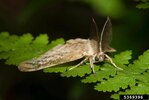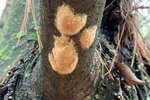


"What is going on?!"
"I've never seen it like this!"
Those were typical comments from Rondout Valley residents as tiny black caterpillars began to rain down in early May, drifting through the air and landing on driveways, people, lawn furniture, cars, and on shrubs and trees, whose tender new leaves they immediately began devouring.
“There are more than usual," commented Francis Groeters of the Catskill Native Nursery. "There was a big population last year and they laid a gazillion million eggs. Everywhere we looked over the winter there were egg masses, and they all hatched ... In 25 years, we’ve never seen this many … when we’ve had infestations, I don’t remember them being like this." Would a colder winter have kept down the numbers? "They’re pretty well adapted to cold winters … so, no – they go through these boom-bust population cycles. And this is a boom.”
People were experiencing rashes and itchy spots, not from ticks, chiggers or mosquitos, but from contact with the millions of larvae. "Spongy moths [aka gypsy moths] can be a concern to humans especially when they’re really small," said DEC forester Rob Cole. “They do this thing called ballooning, where they let out a piece of silk and float through the air on it. These floating caterpillars can come into contact with you, inadvertently, and you can end up with a skin irritation or rash." The rash is explained by histamines in the caterpillars' leg hairs, which can even get into the air, causing allergic reactions. The good news, Cole added, is that "caterpillars only do this for a few weeks and then you come into less contact with them and that risk of getting the rash goes down."
However, as the hazard to humans subsides, the caterpillars will just be getting started on attacking the trees. They'll be increasing in size. The NYS DEC website informs us that "Spongy moth caterpillars grow to about 2.5 inches in length and have five pairs of raised blue spots followed by six pairs of raised red spots along their backs." As they grow, of course their appetites grow.
“Spongy moth caterpillars are known to feed on the leaves of a large variety of trees such as oak, maple, apple, crabapple, hickory, basswood, aspen, willow, birch, pine, spruce, hemlock and more. Oak is their preferred species." Long-time residents can probably remember summers when oaks along the Shawangunk Ridge were so severely defoliated by spongy caterpillar damage that midsummer looked like early spring. The trees had to muster their forces to put out a second set of leaves, which they have the ability to do. However, the DEC info page continues, "defoliation can reduce the health and vigor of a tree, causing it to become more susceptible to other stressors such as extreme drought, flooding or attacks by disease or other insects."
There are things you can do to reduce the stress on individual trees and shrubs you want to protect. Groeters thought that Neem oil could help to kill the caterpillars on a plant. More lethal is a natural insecticide called Bacillus thuringiensis (Bt), which doesn’t hurt anything other than caterpillars. “Of course that does include butterflies and good moths as well, so you want to be careful to spray that only on plants that you see the [spongies] on,” Groeters advised. Another note: Tent caterpillars look similar to spongy moths and also feed in the spring. However, tent caterpillars are a native species and are an important food source for birds and other wildlife.
Because spongy moths are an invasive species, predators are not many. Cole said, “cuckoos, catbirds will go for them. But there’re just so many caterpillars and [relatively] only a few birds.” His advice for homeowners: "If they see the caterpillars early in the season, we recommend using sticky bands on your yard trees. This will catch the caterpillars as they walk up and down during the day." (However, Groeters pointed out that butterflies and even hummingbirds also get caught in these sticky bands, so the Catskill Native Nursery doesn't recommend them.)
"Later in the season, as the caterpillars are looking for places to pupate, we recommend using burlap bags tied around the trees. Homeowners can also scrape egg masses after eggs have been laid in the fall. We have detailed instructions on how to do these activities on our DEC website," Cole added. There are plenty of images of the spongies' light-brown egg masses on tree trunks too.
When the caterpillar drift en masse on the breeze, they are scattered literally to the four winds. They will find some tree or shrub to crawl up and begin munching. You will know they are up there when you start to see tiny bits of leaf litter appear on tree-lined roads.
Though it's hard to believe when it feels like you're in the center of a caterpillar disaster movie, according to Cole "this year we’re not expecting to have as large an outbreak as we’ve had in the past. A couple of years ago it was 730,000 acres. Last year, it went down to under 200,000 acres and based on the weather we’ve been having, we expect that acreage to continue to decline." To the north, the spongy moth hatch-out won't be unusually large. "At this point, we’re getting a lot of reports from the lower Hudson Valley, which is what we expected based on where last year’s population was ... Most of the action will be definitely south of Albany."
So we in the Rondout Valley get the spongy moth booby prize this year. But Groeters tried to be optimistic. “We’re hoping the rain will slow them down. There’s a naturally occurring fungus that spreads readily when it’s rainy and cool, and that’s what we’re getting right now.” The day that he spoke, it was chilly and wet, with similar weather expected for a couple more days. Good old regular rain, it must be admitted, is better than caterpillar rain.
For how to recognize their egg masses in the fall, and lots more spongy moth information, visit Cornell Cooperative Extension at ccecolumbiagreene.org/gardening/pests